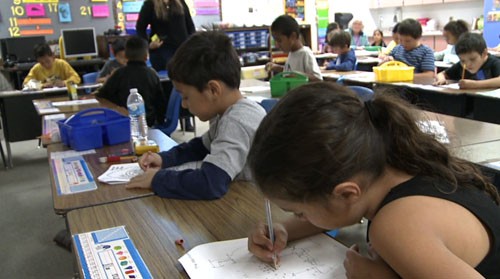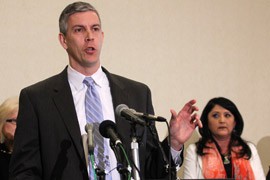Cronkite News has moved to a new home at cronkitenews.azpbs.org. Use this site to search archives from 2011 to May 2015. You can search the new site for current stories.
Arizona superintendent describes ‘sequestration’ impact on schools
WASHINGTON – An Arizona school superintendent said Monday that her district has already cut 40 positions because of automatic federal spending reductions and will recommend cutting 65 more and closing three schools next year to save money.
“It’s a very difficult time,” Window Rock Unified School District Superintendent Debbie Jackson-Dennison said of the so-called “budget sequestration” that went into effect Friday.
“Our community already faces severe social and economical disadvantages that sequestration will add to,” she said at a news conference in Washington.
Jackson-Dennison joined five other superintendents from around the country whose districts are heavily dependent on federal impact aid and who experienced cuts even before they took effect Friday.
The members of the National Association of Federally Impacted Schools represent districts that rely on federal funds to make up for the loss of property taxes because of the presence of large amounts of tax-exempt federal property.
That reliance forced the districts to begin budgeting for sequestration last year, when it appeared the cuts might hit as early as Jan. 1. They said they now have to plan as if those cuts will continue into next year.
The superintendents, who were joined by U.S. Education Secretary Arne Duncan, called on Congress to make a deal to stop the cuts.
“I honestly thought we would never be in this position,” Duncan said, adding sequestration was created as a self-imposed threat to force a dysfunctional Congress to come to an agreement.
“And because they were so dysfunctional they made sequester so painful they thought it would be impossible for it to actually happen,” he said. “I’m stunned that we’re here.”
If there is no agreement to head off the federal spending cuts this year, Jackson-Dennison said it will mean more cuts to her seven-school district and its enrollment of 2,400 students, almost all of whom are Navajos.
Additional cuts the district is preparing will include five administrator positions, 25 support staff and 35 teachers. Officials will also recommend that the governing board close two elementary schools and combine the traditional and alternative high schools into one.
She said students in the district’s four remaining schools will face more crowded classrooms, fewer staff and longer bus rides to school.
The district is also planning to trim its Navajo language immersion school from a kindergarten through eighth grade program to end in fifth grade, “which already the community is in an uproar about,” Jackson-Dennison said.
Chris Kotterman, deputy director of government relations for the Arizona Department of Education, said Window Rock schools are experiencing cuts that other Arizona districts will not have to face for several months still.
But if a budget deal is not reached by July, Kotterman said, cuts will have to be made in those districts that do not rely as heavily on federal aid.
Kotterman said cuts would disproportionately hit low-income and special education schools, which get more federal funding than other schools. But they won’t know how much to cut until Congress strikes a budget deal – or not.
In the meantime, Arizona school districts are going to start budgeting for school year 2013-2014 within the next month, he said.
“It would help them to know exactly what they’re dealing with,” Kotterman said. “The longer it goes on, the more uncertainty there is.”
In Window Rock, where sequester-driven cuts are already taking hold, Jackson-Dennison said she does not “know how we’ll ever recover from this.”
“We work so hard to provide (quality schools) and then to pull the rug out from under us,” she said, “it’s just unreal.”










